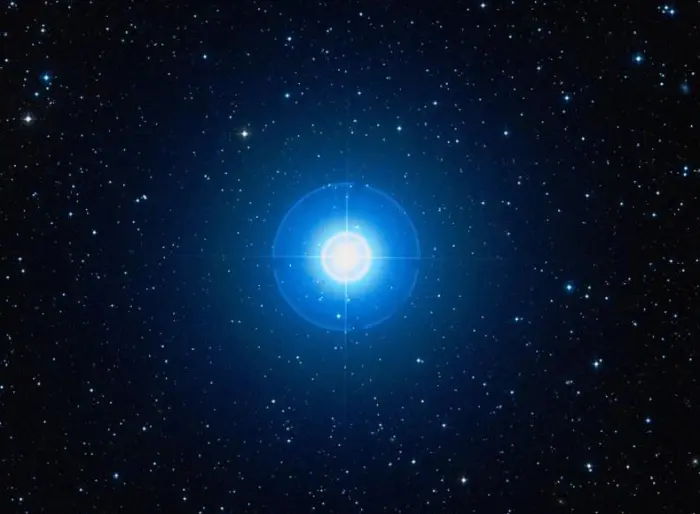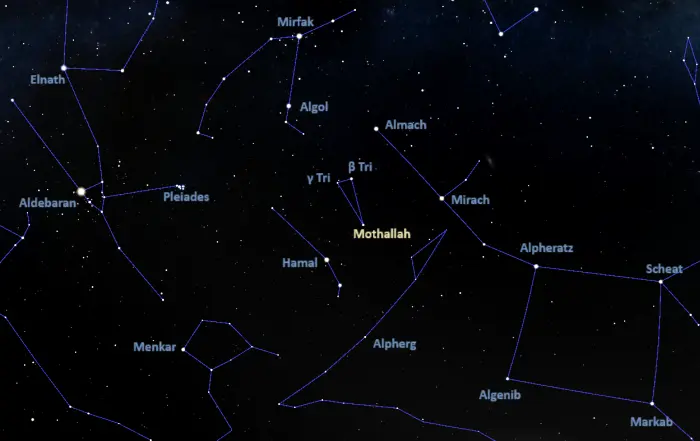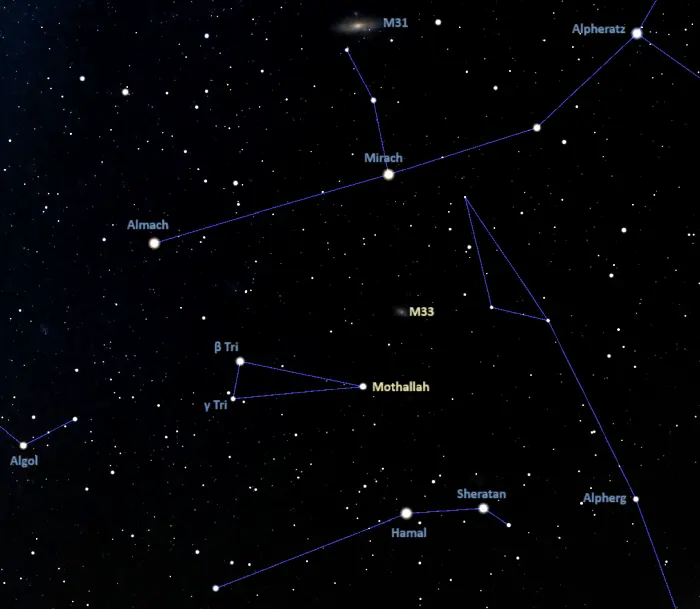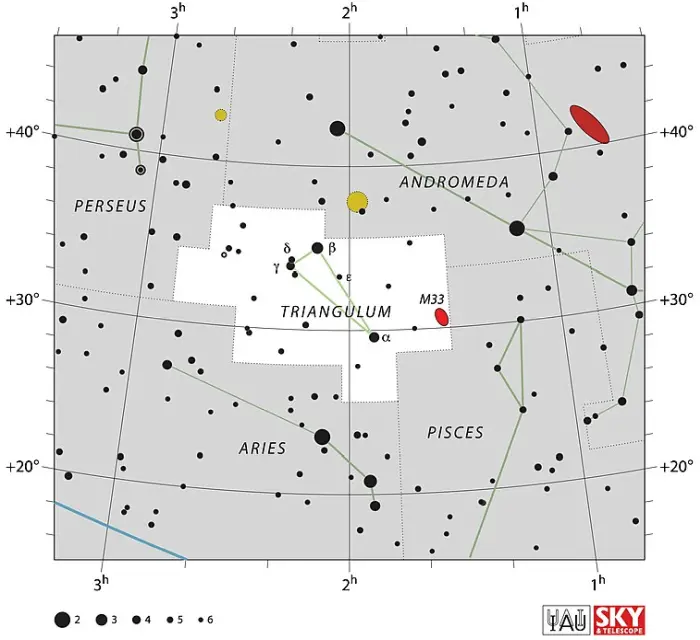Mothallah, Alpha Trianguli (α Tri), is a spectroscopic binary star located 63.3 light-years away in the northern constellation Triangulum. With an apparent magnitude of 3.42, it is the second brightest star in the constellation, after Beta Trianguli.
Mothallah marks the apex of the triangle that gives the constellation its name. It can be used to find the Triangulum Galaxy (M33), one of the most distant objects visible to the unaided eye.
Star system
Alpha Trianguli is a spectroscopic binary system with an orbital period of only 1.767 days. The two components cannot be visually resolved. The system has the combined spectral type from F5III to F6IV, indicating that the primary component, Alpha Trianguli A, is a yellow-white giant or subgiant star.
Mothallah (α Tri A) has a mass of 1.70 solar masses and a radius 3.22 times that of the Sun. It has an effective temperature of 6,288 K. The evolved star is believed to be 1.6 billion years old.
Alpha Trianguli A is a fast spinner. It has a projected rotational velocity of 81.6 km/s. As a result of its high spin rate, the star has the shape of an oblate spheroid. It is flattened at the poles and has an equatorial bulge.
The companion, Alpha Trianguli B, is a red dwarf with 11% of the Sun’s mass and a radius 14% that of the Sun.
In the next few million years, Mothallah will continue to expand into a red giant. As it does, the Alpha Trianguli system may evolve into a semi-detached binary star. The two components will be close enough for gas from the surface of one star to be transferred to the other star.
Mothallah is classified as a rotating ellipsoidal variable. Ellipsoidal variables are close binary systems that vary in brightness because the components are ellipsoidal in shape.
Unlike Algol-type variables, the binary companions do not eclipse each other. Instead, the brightness variations are caused by the changes in the light-emitting area visible from Earth during the stars’ orbit. The fluctuations in visual magnitude typically do not exceed 0.1 magnitudes.
Other variable stars in this class include Spica in the constellation Virgo, Pi Cassiopeiae in Cassiopeia, 68 Cygni in Cygnus, and Pi5 Orionis in Orion.

Mothallah (Alpha Trianguli), image credit: ESO/Digitized Sky Survey 2 (CC BY 4.0)
Facts
Mothallah is one of only two formally named stars in the constellation Triangulum. The other, Horna (HAT-P-38), was only named in 2019 and is invisible to the unaided eye.
Mothallah forms a prominent elongated triangle with Beta and Gamma Trianguli. It is the nearest of the three stars to the Sun. The brighter Beta Trianguli is a white giant located 141 light years away and the fainter Gamma Trianguli is an A-type main sequence star 112.3 light-years away. Both stars are younger and more massive than Mothallah.
Name
The name Mothallah (pronunciation: /məˈθælə/) comes from the Arabic phrase raʼs al-muthallath, meaning “the head of the triangle.” It was traditionally also spelled Ras al Muthallah. The name was translated into Latin as Caput Trianguli.
The International Astronomical Union’s (IAU) Working Group on Star Names (WGSN) approved the name for Beta Trianguli A on August 21, 2016.
In Arabic astronomy, Mothallah (Beta Trianguli) and Alpha Trianguli were known as Al Mīzān, “The Scale Beam.”
In Babylonian astronomy, Mothallah was called UR.BAR.RA (the Wolf) and described as “the seeder of the plough” in the MUL.APIN, a Babylonian astronomical compendium dating from around 1000 BCE. The Plough was the name of a constellation formed by the stars of Triangulum with Almach (Gamma Andromedae) in Andromeda.
Location
Mothallah is easy to find because it lies near the recognizable star patterns of Andromeda, Perseus and Aries. It is the brightest star in the region between Mirach in Andromeda and Hamal in Aries.
The stars of Andromeda and Aries can be found using the bright, large Great Square of Pegasus, an asterism that dominates the evening sky during the northern hemisphere autumn. The three brightest stars of Andromeda – Alpheratz, Mirach and Almach – form an almost straight line between Pegasus and Perseus, while the luminaries of Aries form a flat triangle.

The location of Mothallah (Alpha Trianguli), image: Stellarium
Mothallah and Mirach can be used to find the Triangulum Galaxy (Messier 33), the third largest galaxy in the Local Group, after Andromeda (M31) and the Milky Way. The Triangulum Galaxy lies close to the imaginary line connecting Mirach in Andromeda and Hamal in Aries. Mothallah is the nearest relatively bright star to the galaxy.

Mothallah and the Triangulum Galaxy (Messier 33), image: Stellarium
Constellation
Mothallah lies in the constellation of Triangulum (the Triangle). Located between the brighter Andromeda and Aries, Triangulum is recognizable for its distinctive constellation figure, formed by its three brightest stars. The celestial Triangle stretches across only 132 square degrees of the northern sky and is the 78th largest of the 88 modern constellations.
Triangulum is one of the Greek constellations catalogued by Claudius Ptolemy of Alexandria in his Almagest in the 2nd century CE. The ancient Greeks called the constellation Deltoton (Δελτωτόν) because its prominent constellation pattern resembled the Greek letter delta (Δ). The name was Latinized into Deltotum. It has historically also applied to the constellation’s brightest star, Beta Trianguli.
Triangulum is one of the fainter northern constellations, but it can be spotted on a clear night from areas without too much light pollution. The lucida Beta Trianguli, a binary system composed of two A-type giants, shines at magnitude 3.00 from a distance of 141 light-years.
Other notable stars in the constellation include the young A-type main sequence star Gamma Trianguli, which has a debris disk with a radius of 80 astronomical units (AU), the spectroscopic binary system Delta Trianguli, composed of two Sun-like stars, the quadruple star system Iota Trianguli, the F-type giant star 12 Trianguli, and the red giants 15 Trianguli and R Trianguli.

Triangulum constellation map by IAU and Sky&Telescope magazine (Roger Sinnott & Rick Fienberg) (CC BY 3.0)
Deep sky objects in Triangulum include the Triangulum Galaxy (M33), one of the most distant objects visible to the unaided eye in exceptionally good conditions (along with the Andromeda Galaxy), the bright open cluster NGC 6025 (Caldwell 95), the barred spiral galaxies NGC 925, NGC 672 and NGC 784, the elliptical galaxies NGC 785, NGC 807 and NGC 860, and 3C 48, the first quasar ever observed.
The best time of the year to see the stars and deep sky objects in Triangulum is during the month of December, when the constellation is higher above the horizon in the early evening. The entire constellation is visible from locations north of the latitude 60° S.
The 10 brightest stars in Triangulum are Beta Trianguli (mag. 3.0), Mothallah (Alpha Tri, mag. 3.42), Gamma Trianguli (mag. 4.01), Delta Trianguli (mag. 4.865), Iota Trianguli (mag. 4.95), 14 Trianguli (mag. 5.14), 7 Trianguli (mag. 5.25), 10 Trianguli (mag. 5.29), 12 Trianguli (mag. 5.37), and 15 Trianguli (mag. 5.396).
Mothallah – Alpha Trianguli
| Spectral class | F5III -F6IV + M |
| Variable type | Rotating ellipsoidal variable |
| U-B colour index | +0.06 |
| B-V colour index | +0.48 |
| Apparent magnitude | 3.42 |
| Absolute magnitude | 1.98 |
| Distance | 63.3 ± 0.3 light-years (19.42 ± 0.09 parsecs) |
| Parallax | 51.3310 ± 0.5563 mas |
| Radial velocity | −12.6 ± 0.9 km/s |
| Proper motion | RA: 12.341 ± 0.851 mas/yr |
| Dec.: -233.040 ± 0.860 mas/yr | |
| Mass (α Tri A, α Tri B) | 1.70 M☉, 0.11 M☉ |
| Radius (α Tri A, α Tri B) | 3.22 R☉, 0.14 R☉ |
| Temperature (α Tri A) | 6,288 K |
| Metallicity (α Tri A) | -0.09 – 0.00 dex |
| Age (α Tri A) | 1.6 billion years |
| Rotational velocity (α Tri A) | 81.6 km/s |
| Surface gravity (α Tri A) | 3.91 cgs |
| Constellation | Triangulum |
| Right ascension | 01h 53m 04.9054187154s |
| Declination | +29° 34′ 43.747211027″ |
| Names and designations | Mothallah, Alpha Trianguli, α Trianguli, α Tri, Caput Trianguli, 2 Trianguli, HD 11443, HR 544, HIP 8796, SAO 74996, FK5 64, BD+28°312, AG+29 233, PPM 91161, GC 2272, GCRV 1046, GJ 9062, GJ 78.1, LTT 10647, NLTT 6290, PLX 390.00, N30 387, TD1 1077, LSPM J0153+2934, GSC 01763-03028, ASCC 652427, CNS5 486, CSI+28 312 1, JP11 547, IRC +30031, PMC 90-93 46, TIC 28244955, UBV 1876, UBV M 8470, RBS 250, ROT 264, 1E 0150.2+2919, 2E 495, 2E 0150.2+2919, 1ES 0150+29.3, SKY# 2767, EUVE J0153+29.5, 2EUVE J0153+29.5, USNO-B1.0 1195-00024212, RX J0153.0+2934, 1RXS J015305.0+293440, uvby98 100011443, SBC7 65, SBC9 94, IRAS 01502+2919, 2MASS J01530489+2934442, TYC 1763-3028-1, Gaia DR2 299464296906886016, Gaia DR3 299464296907113984, CCDM J01531+2935A, IDS 01474+2906 A, WDS J01531+2935A |